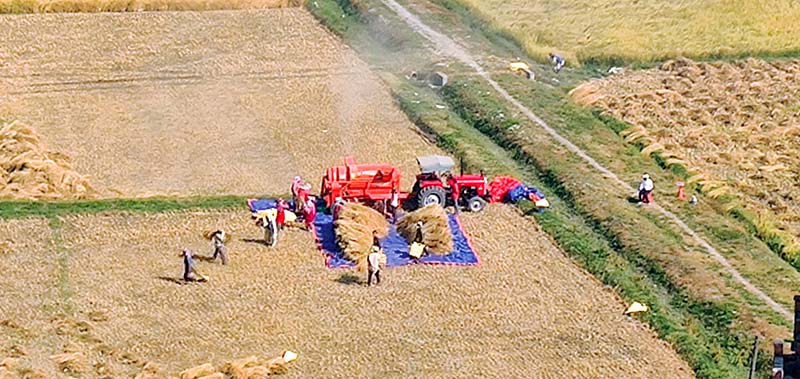Sixty per cent paddy harvesting completed
KATHMANDU, NOVEMBER 5
More than 60 per cent of paddy harvesting has been completed across the country so far, according to the Ministry of Agriculture and Livestock Development (MoALD).
According to Hari Bahadur KC, spokesperson for MoALD, the primary production statistics of paddy are expected to come within Tihar.
“Since the plantation area has increased this year compared to last year, paddy production is also expected to rise this year,” KC assumed, further explaining the increase in plantation area to more people being engaged in the plantation due to the nationwide lockdown coinciding with the plantation season.
However, Navaraj Basnet, president of Nepal Farmer’s Group Association, stated that despite the increase in paddy plantation area, paddy production is unlikely to increase since the farmers could not get the necessary material inputs for rice production on time because of the COVID-19 crisis and short supply of fertilisers.
“Due to the shortage of fertilisers, production has been damaged at several places in the country,” he said.
Basnet further said that paddy production should have increased by 10 to 20 per cent considering the increase in paddy plantation area, favourable monsoon and good irrigation, but it will be similar to or even less than last year.
Paddy has been planted on 1,469,431 hectares of land this year. Last year, paddy was planted on 1,315,282 hectares, which produced 5.55 million metric tonnes of paddy.
Despite being an agrarian country, the import of agricultural produce, including rice, is escalating every year in Nepal.
As per the statistics of the Department of Customs, paddy and rice import doubled in first three months of current fiscal compared to the same period of last fiscal. The statistics reveal that Nepal imported paddy and rice worth Rs 10.6 billion in the first three months of current fiscal whereas its import had stood at Rs 5.06 billion during corresponding period of last fiscal.
“The growing population and rising consumption have contributed to surging imports of rice in the country.
However, if paddy production goes up this year, it is expected that import will shrink in later months of fiscal,” opined KC.
On the other hand, Basnet said that Nepalis have to improve their food consumption habit to decrease the import of rice. “As rice production is minimal in the hilly and mountainous regions, the people in those areas tend to buy imported rice, which has increased the import of rice in the country,” he said.
Meanwhile, to fulfil the domestic demand for rice, local production could have been boosted if the government had supported the farmers but it has not been able to do so, as per Basnet.






